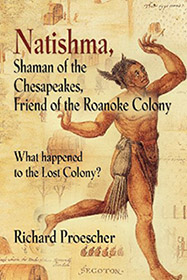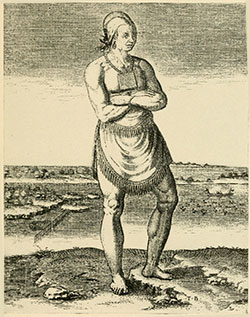Book Review: "Natishma, Shaman of the Chesapeakes,
Friend of the Roanoke Colony" by Richard Proescher

The plot is a coming-of-age story at a pivotal historical moment when the early English explorers visit Tidewater, Virginia, and the Elizabeth River area. The book starts when Natishma is in late childhood and experiences his first journey to the upper world. Natishma is still determining if he can fulfill the role of shaman. He is slight in stature, has a humped back, and is considered a contrary, which leads to taunting and teasing by other young men of the tribe. We follow him as he grows and has more visionary experiences. During his huskanaw, or rite of passage into adulthood ceremony he is stuck by lightning, "Pokea-Ta-wer threw his power clubs." While Natishma is unconscious he has a vision of "men with the skin of dirty snow" arriving on the shores of the Chesapeake Bay.
We also follow the progress of Thomas Hariot and his ship the "Tiger." Among his crew are two Native Americans who were persuaded to visit England, Manteo and Wanchese. Manteo is familiar with the Chesapeake tribe and suggests that the English visit Natishma's village. Once the English arrive they show the villagers many wonderful devices like mirrors, magnifying glasses, and maps. The tribe members are astonished but question why the visitors aren't able to find food for themselves and why they smell so bad.

Natishma has had visions of great changes that these new people will bring and has been warned to live in harmony with them. He visits Northern tribes to learn about Aiontwatha, (Hiawatha), who united tribes and was the founder of the Iroquois Confederacy.
The clash of cultures doesn't end well. The English unwittingly bring disease and the Native peoples fight the intrusion into their territory.
The book is very well-researched with a glossary containing words in the Native American language. It looks at the everyday life of the Chesapeake Indians, food, medicine, and inter-tribal warfare. It also shows Natishma's connection with nature and how that guides his decisions. The last chapter ties the book to historical documents and predicts that in the near future people will reclaim their connection to spirit and the earth.
The book gives us an understanding of the dangers of life for both the native peoples and the English settlers but it is not a power-packed action drama where the characters do superhuman stunts.
I enjoyed the research into the native way of life. It was an interesting glimpse of how another culture lived in an area we take for granted. I also would like to learn more about John White, the expedition's artist and mapmaker.
Links to more information
- Natishma.wordpress.com The author's web site
- Chesapeake people Wikipedia.org
- ElizabethRiver.org The Elizabeth River web site
Book Details
- Title: "Natishma, Shaman of the Chesapeakes, Friend of the Roanoke Colony"
- Author: Richard Proescher
- Publisher: Booklocker.com, Inc.
- Publication date: January 15, 2013
- Book length: 266 pages
- ISBN-13: 978-1626460270